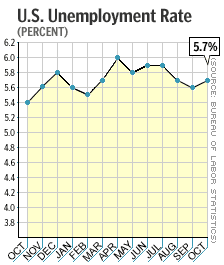NEW YORK (CNN/Money) -
The U.S. economy has shown signs of life lately, and Friday's unemployment report could bring better-than-expected news about the labor market -- but many economists still doubt a flood of new jobs is on the way anytime soon.
"I wouldn't be surprised if unemployment held constant or dropped a tenth of a percentage point," said Jared Bernstein, labor economist with the Economic Policy Institute. "But will [that] signal we're heading back to a healthy labor market? No, because the economic fundamentals, in terms of growth, just aren't there."
Economists, on average, expect the Labor Department to report that the U.S. unemployment rate rose slightly to 5.8 percent in November from 5.7 percent in October, according to estimates compiled by Briefing.com.

And economists, on average, think U.S. businesses added 35,000 jobs to their payrolls in November after cutting 5,000 in October, according to Briefing.com.
Though it might be something of a head-scratcher to see unemployment go up even as new jobs are created, the two numbers come from different surveys -- the unemployment number comes from a survey of households, while the payrolls number comes from a survey of businesses -- so they don't always move in perfect unison.
And many economists think the market needs to be absolutely flooded with jobs -- 125,000 new jobs or more per month -- in order to meet the demand from the ever-growing labor market. If not enough jobs are created, the unemployment rate goes up.
Unfortunately, not many economists think such robust job growth is near at hand, especially since the economy hit a "soft patch," as Alan Greenspan described it, in the fourth quarter.
"Through the first half of next year, I suspect the hiring pace will be very sluggish," said Mike Niemira, senior economist at Bank of Tokyo-Mitsubishi Ltd. "What we're probably seeing is an inflection point, where there's not a lot of hiring, but the rate of firing is starting to ease up."
Pent-up demand for workers?
U.S. businesses cut more than 1.8 million jobs during a recession that began in March 2001, driving up the national unemployment rate. Though the economy has grown more or less steadily this year, companies have been reluctant to add new workers, and the economy's latest "soft patch" led to another round of job cuts.
But recent positive economic signs -- including improving measures of consumer confidence and a downward trend in new claims for unemployment benefits -- would seem to indicate that a labor-market recovery is right around the corner, and a few optimistic economists think it is.
| Related stories
|

|
|
|
|
"There's no question in my mind that the labor market is improving," said Anthony Chan, chief economist at Banc One Investment Advisors.
Chan said he thinks about 40,000 new jobs were added to payrolls in November, and he expects that number to improve every month as businesses realize they've been too stingy when it comes to hiring.
"You typically see, from the trough of a recession to the time when the recession ends, a 1.3-percent gain in payrolls," Chan said. "From when the recession likely ended, in December of last year, we've had 0.004 percent gain, instead of that 1.3 percent gain. There's a pent-up demand for labor, given such a jobless recovery."
The timing of that rebound in hiring has been delayed, in part, because businesses have been able to squeeze more work out of fewer workers. As a result, productivity growth has positively exploded, helping corporate profits weather the downturn.
If demand and economic growth pick up next year, as many economists think it will, then businesses might finally have an incentive to produce even more goods and hire more workers. That could lead to reasonably strong growth by the second half of 2003, if not earlier.
"What generally happens is, during the first year of economic expansion, we see more productivity growth than job growth, and that changes as you go into the second year," said Putnam Investments economist David Kelly. "We may be on the cusp of that."
The problem of pricing power
But even if demand improves, companies may still be unwilling to hire new workers if they continue to struggle to raise prices -- several measures of price inflation are at their lowest levels since the 1950s and have shown no signs of increasing yet.
If prices do not improve significantly, then hiring might not really rebound until 2004 -- or later.
"All through the economy, businesses are finding they're unable to raise prices, so revenues are not growing in the way they would have liked," said Kevin Logan, chief market economist at Dresdner Kleinwort Wasserstein. "Without revenue growth, they're not going to grow profits. The only way to grow profits then is to cut costs, and the only way to do that is to not hire workers."
And if businesses aren't hiring, that could put a dent in consumer spending, which fuels two-thirds of the total economy. Consumers have been propping up the economy for months, despite a recession, terror attacks, falling stock prices and other woes. Economists had hoped businesses would help out by hiring more workers; if they don't, then the economy might need Congress to come to the rescue.
"The consumer's been doing a fine job, but we can't keep tapping them and expect them to get us out of a jobless recovery," said Bernstein of the Economic Policy Institute. "That's why lots of people on both sides of the aisle are asking for fiscal stimulus."

|

